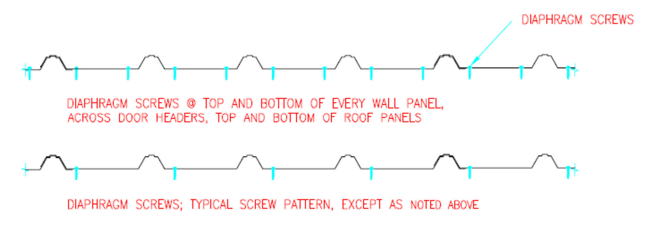Through Screw Steel Roof Leaks
Reader DEBRA in KERSEY writes:
“20 years ago my husband Jim and I bought a 40×60 pole barn and it’s been wonderful except for the leaks in the roof. After reading some of your online articles about roof leaks, I wanted to get in touch with you and see if any materials had improved since 2004. Jim wants to reseal with sealant every screw in roofing so I want to make sure we know if there are any upgraded materials you are selling for your older building kits that might help with this issue. Jim is now 77 and I really don’t want him up on that roof for this job and am hoping you have an alternate idea for me Looking forward to hearing from you.”

Properly installed, through screwed steel roofing, with correct screws, on a fully engineered post frame (pole barn) building should never pose a leaking challenge.
Mike the Pole Barn Guru says:
Let’s look at why buildings leak.
If leaks are discovered immediately following construction completion they are most often from:
Roof steel lapped in wrong direction (three-quarter lap goes OVER full lap – even “professional” builders make this error)
Screws not properly being seated (under driven or driven at an angle allowing water to seep in around shank of screw, or over driven crushing gasket under screw head)
Screws missing roof purlins (most often due to roof steel not being pre-drilled, or purlins not being adjusted to straight during installation)
No provision to control condensation (this is most often seen in Spring and Fall when dew points are higher than ambient air temperatures). This truly is not a leak, but feels like one. It can be solved by application of two inches of closed cell spray foam to the underside of roof steel.
Closures missing from beneath the ridge cap.
Leaks over time:
Improper screw patterns (screws must be placed into each roof purlin, at the side of steel ribs away from overlap then every nine inches. At eave and ridge, screws must be each side of each high rib)
Screws were placed in high ribs, rather than in flats (it is impossible to perfectly seat every screw into crowns of high ribs. Even using a screw gun with a clutch, variations in stiffness of roof purlins cause screws to not all be identically driven. As wind cycles into your building roof, shank of screws in void between crown of high ribs and purlins will flex slightly and over time cause slotting around shanks)
Inadequate screw diameters – we subjected a full scale roof to cyclical loads, to failure. We found industry standard #10 screws in areas of high shear loads (at eave and ridge) began slotting below fastener heads. When slots became long enough, roof leaked.
Screws without EPDM gaskets below grommets – most screws have neoprene rubber gaskets. Neoprene is not UV resistant and will deteriorate in a matter of very few years.
Poor screw coatings – cheap screws have only minimal electroplated galvanization. Once this wears through, screws will rust and decay quickly.
There is no sealant capable of adequately solving individual roof leaks beyond just a very short term. I have tried it myself and it is not an approved method of correcting leaks endorsed by any steel roll former. There are roofing coating systems advertising their ability to completely seal entire roofs. I have never used one, so cannot speak to their effectiveness, durability or how they look.
Without knowing more about your building’s leak specifics (where does it leak, when does it leak, how long has it leaked) it is difficult to recommend a possible solution or solutions. In most cases, provided ridge closures are intact and not decayed, if screws were placed in flats – replacing all screws with larger diameter, longer screws, powder coated with EPDM gaskets can resolve leak issues.






